foreword
With the more and more frequent use of electrical appliances, the number of times we use electrical products in our lives also increases. The use of electrical appliances relies on electric energy, which is very harmful to our human body, so we need to pay great attention to electrical products. Today, Xiaobian is going to introduce the SCR model.
With the more and more frequent use of electrical appliances, the number of times we use electrical products in our lives has also increased. However, the use of electrical appliances relies on electric energy, which does great harm to our human body. Therefore, we need to pay great attention to electrical products. Today, Xiaobian is going to introduce SCR models. Please see the introduction of SCR models below.
Introduction of SCR parameters and models
Silicon controlled rectifier (SCR), the abbreviation of SCR rectifier, is a high-power semiconductor device with four layers of three PN junctions, also known as thyristor. With the characteristics of small size, relatively simple structure and strong functions, it is one of the commonly used semiconductor devices. This device is widely used in all kinds of electronic equipment and products, such as controllable rectification, inverter, frequency conversion, voltage regulation, contactless switch, etc. Silicon controlled devices are widely used in dimming lamps, speed regulating fans, air conditioners, TV sets, refrigerators, washing machines, cameras, stereo sets, acousto-optic circuits, timing controllers, toy devices, radio remote control, video cameras and industrial controls. The electrode leads of the bidirectional thyristor are irregular, and the G pole is usually led out at the T1 pole side instead of the T2 pole side. There is still a difference between the two main electrodes T1 and T2 of the triac. The trigger of the triac is usually relative to the current between T1 and G.
1、Parameters of SCR
(1) Classification according to turn-off, turn-on and control modes: SCR can be divided into ordinary SCR, bidirectional SCR, reverse thyristor, gate turn-off thyristor (GTO), BTG thyristor, temperature-controlled thyristor and light-controlled thyristor according to its turn-off, turn-on and control modes.
(2) Classification by pin and polarity: SCR can be divided into two-pole SCR, three-pole SCR and four-pole SCR according to its pin and polarity.
(3) Classification according to packaging form: SCR can be divided into three types according to its packaging form: metal packaged SCR, plastic packaged SCR and ceramic packaged SCR. Among them, metal-encapsulated SCR is divided into bolt shape, flat plate shape, round shell shape, etc. Plastic-sealed SCR is divided into two types: the type with heat sink and the type without heat sink.
(4) Classification according to current capacity: SCR can be divided into high power SCR, medium power SCR and low power SCR according to current capacity. Usually, high-power silicon controlled rectifiers are mostly packaged in metal shells, while medium and low-power silicon controlled rectifiers are mostly packaged in plastic or ceramic.
(5) Classification according to turn-off speed: SCR can be divided into ordinary SCR and high-frequency (fast) SCR according to its turn-off speed.
(6) Zero-crossing trigger-generally, it is power adjustment, that is, when the sine alternating current voltage phase zero-crossing trigger, it must be zero-crossing before it is triggered. Introduction of thyristor parameters.
(VII) Non-zero-crossing trigger-the thyristor can be triggered when the AC voltage is in any phase. The common trigger is phase shifting, that is, the output percentage can be changed by changing the conduction angle (angular phase) of sinusoidal AC.
2. The rated on-state current (IT) is the maximum stable working current, commonly known as current. The IT of commonly used SCR is generally one ampere to several tens of amperes.
Repetitive peak voltage (VRRM) or off-state repetitive peak voltage (VDRM), commonly known as withstand voltage. The VRRM/VDRM of commonly used SCR is generally several hundred volts to one thousand volts.
Control electrode trigger current (IGT), commonly known as trigger current. The IGT of commonly used SCR is generally several microamperes to several tens of milliamps.
Under the specified ambient temperature and heat dissipation conditions, the average current allowed to pass through the cathode and anode.
2、Introduction of common single and bidirectional SCR models
1、Commonly used unidirectional silicon controlled rectifier:
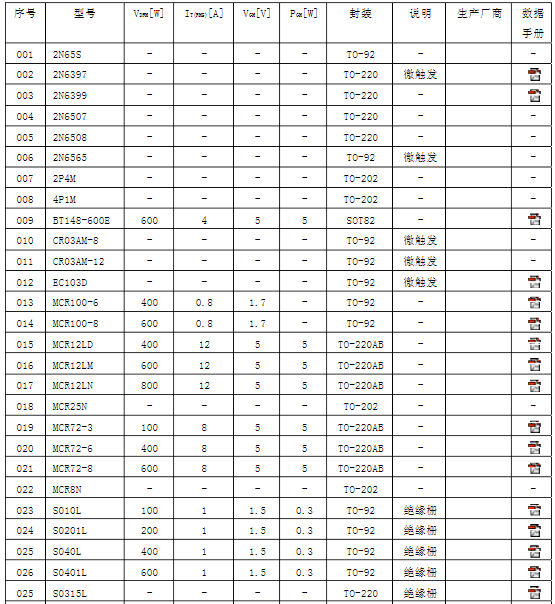
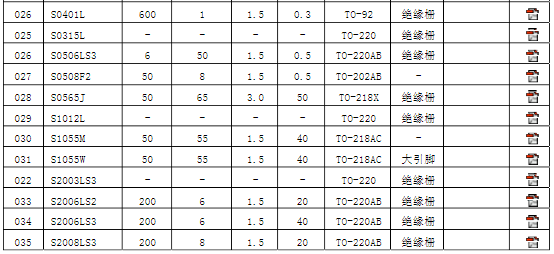
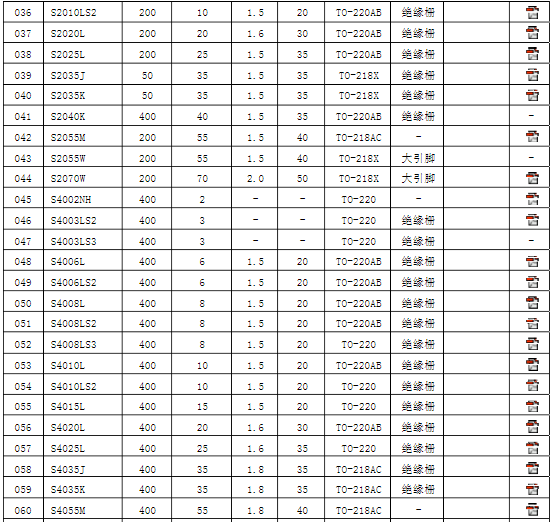
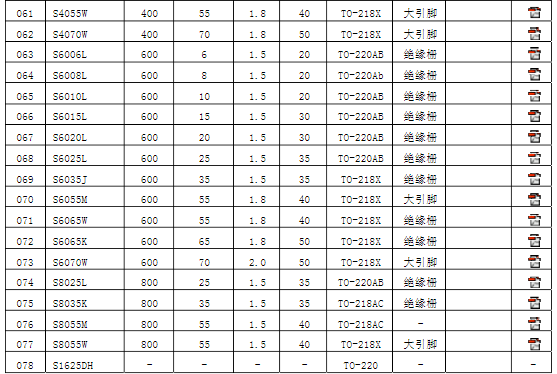

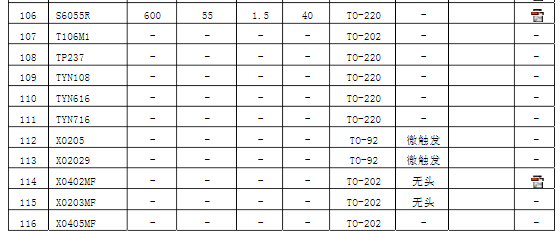
2、Commonly used bidirectional thyristor:
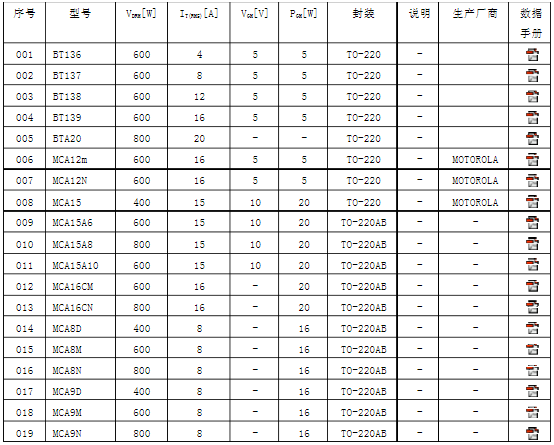
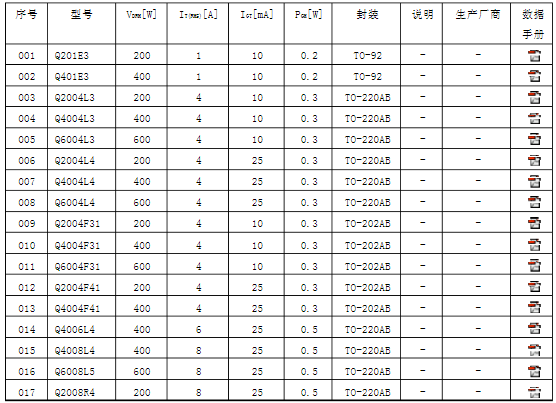
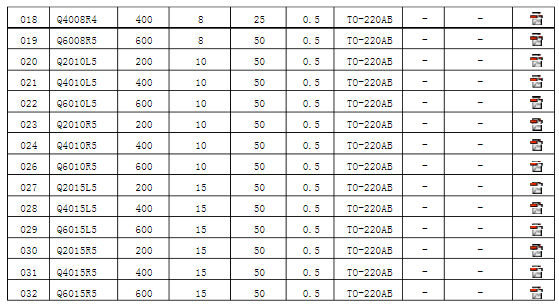
The above is the introduction of SCR models. SCR is the key product used as the control switch of electrical products in our daily life, as well as the function of frequency conversion and voltage regulation. It can help us to better control the use of home appliances, and our understanding of SCR models can help us to make different choices so as to choose different SCR for different electrical products.
Disclaimer: This article is reproduced from "Electronic Enthusiast Network". This article only represents the author's personal views, and does not represent the views of Sacco Micro and the industry. It is only for reprinting and sharing to support the protection of intellectual property rights. Please indicate the original source and author when reprinting. If there is any infringement, please contact us to delete it.
Company Tel: +86-0755-83044319
Fax/fax:+86-0755-83975897
Email: 1615456225@qq.com
QQ: 3518641314 Manager Li
QQ: 332496225 Manager Qiu
Address: Room 809, Block C, Zhantao Technology Building, No.1079 Minzhi Avenue, Longhua New District, Shenzhen

















